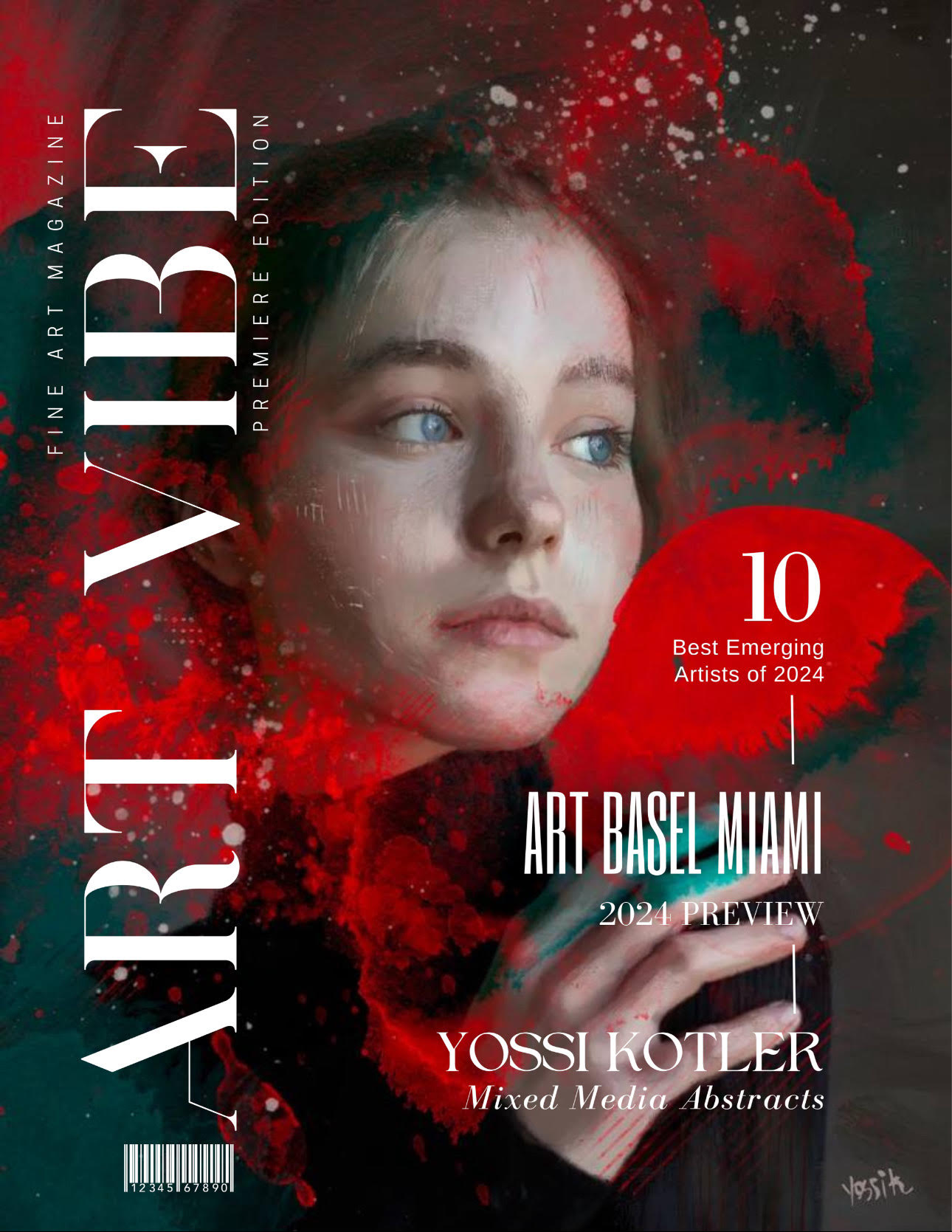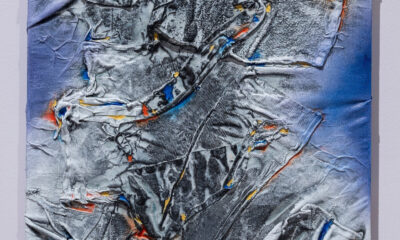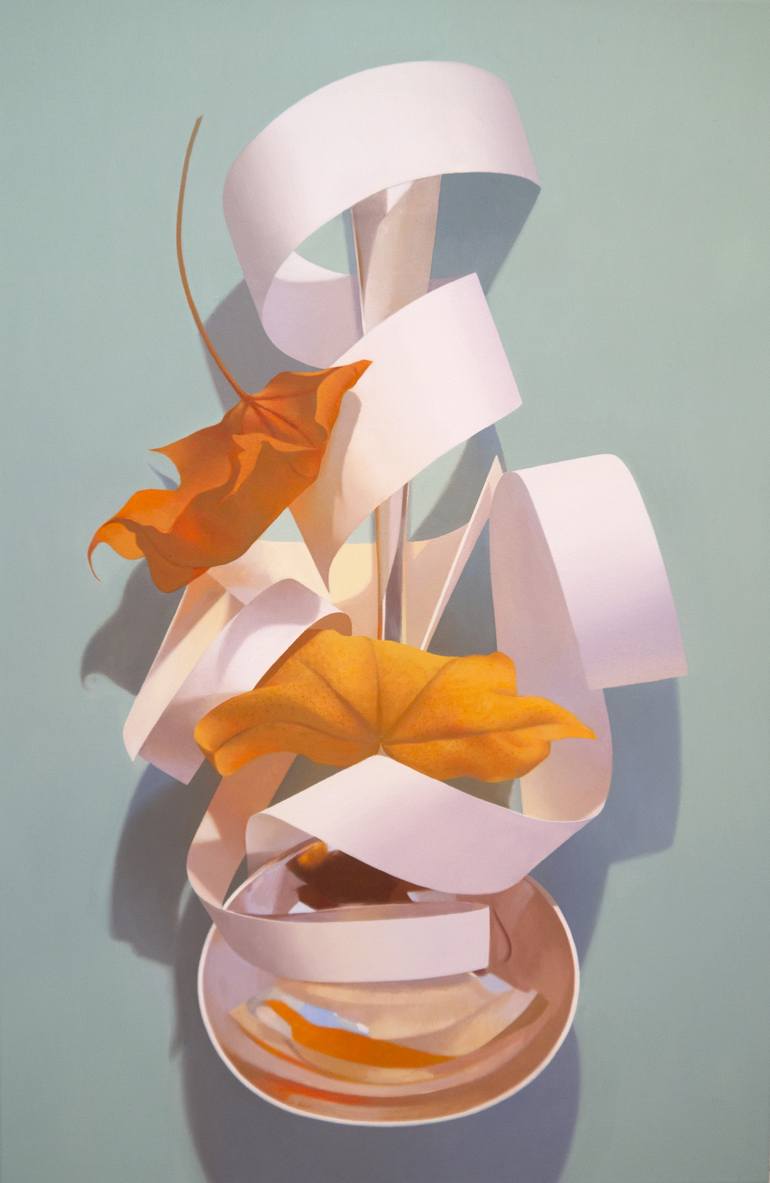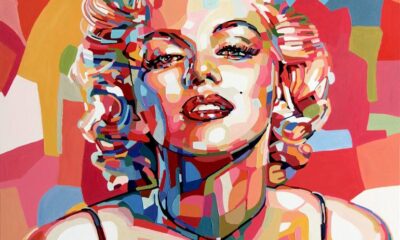Collectors Corner
The Timeless Allure of Oil Paintings in the 21st Century: A Collector’s Perspective

In the ever-evolving landscape of contemporary art, oil painting remains a cherished medium, deeply rooted in tradition yet continually revitalized by modern masters. As a collector, I have often marveled at the resilience and adaptability of oil painting, a medium that has stood the test of time while embracing new techniques and styles. The 21st century has witnessed a remarkable resurgence in the appreciation of oil paintings, driven by both established and emerging artists who are pushing the boundaries of this classic medium.
The Enduring Appeal of Oil Paintings
Oil painting’s appeal lies in its versatility and depth. The richness of color, the subtlety of texture, and the ability to create intricate layers make oil paintings uniquely captivating. This medium allows for a nuanced exploration of light and shadow, bringing a sense of realism and emotional depth that is often unparalleled.
Collecting oil paintings is not just about acquiring art; it’s about preserving a piece of history and engaging with the artist’s narrative. Each brushstroke carries the weight of the artist’s intention, inviting viewers to delve into the story behind the canvas. This connection between the collector, the artwork, and the artist is what makes collecting oil paintings a profoundly enriching experience.
Notable Contemporary Oil Painters
Several contemporary artists are making significant contributions to the world of oil painting, each bringing their unique vision and technique to the medium. Among them, Kehinde Wiley stands out for his vibrant portraits that blend classical European portraiture with African and African-American cultural references. Wiley’s use of oil paint creates a striking contrast between the traditional and the contemporary, making his work both visually stunning and thought-provoking.
Jenny Saville is another influential figure in contemporary oil painting. Known for her large-scale depictions of the human body, Saville’s work challenges conventional notions of beauty and form. Her mastery of oil paint allows her to create dynamic, almost sculptural representations of flesh, capturing the vulnerability and strength of the human condition.
Julie Mehretu’s abstract compositions, though often incorporating mixed media, frequently feature oil paint as a primary medium. Her layered, intricate works explore themes of history, geopolitics, and identity, using the fluidity and depth of oil paint to convey complex narratives.
Kerry James Marshall’s oil paintings delve into the African-American experience, often drawing on historical and cultural themes. His rich, detailed works challenge the exclusion of Black subjects from art history, reclaiming space and visibility through powerful, evocative imagery.
The Modern Collector’s Approach
Collecting oil paintings in the 21st century involves a blend of traditional appreciation and modern sensibilities. While the emotional and aesthetic connection to the artwork remains paramount, contemporary collectors also consider factors such as provenance, market trends, and the artist’s trajectory.
Provenance, or the documented history of an artwork, is crucial in establishing its authenticity and value. Collectors should seek detailed records of ownership, exhibition history, and any relevant publications to ensure the artwork’s legitimacy.
Understanding market trends can also inform a collector’s decisions. Artists like Kehinde Wiley and Jenny Saville, whose works have garnered significant attention and critical acclaim, are likely to appreciate in value over time. However, it is equally important to trust one’s personal taste and emotional response to the artwork. Collecting should be a passion-driven pursuit, not solely an investment strategy.
Embracing Technology
The digital age has transformed the art collecting landscape, making it more accessible and transparent. Online platforms such as Artsy and Saatchi Art provide collectors with access to a vast array of artworks from around the world, allowing for greater diversity and discovery. Virtual auctions and digital galleries enable collectors to view and purchase oil paintings from the comfort of their homes, expanding the possibilities for building a unique and meaningful collection.
However, the tactile experience of viewing art in person remains irreplaceable. Visiting galleries, museums, and art fairs provides an opportunity to engage with the artwork’s texture, scale, and presence—elements that are often lost in digital representation. As a collector, balancing online exploration with in-person engagement enriches the collecting journey.
Conclusion
The allure of oil paintings endures in the 21st century, sustained by the medium’s inherent beauty and the innovative visions of contemporary artists. Collecting oil paintings is a journey of discovery, connection, and preservation, offering profound rewards for those who embrace it. As we navigate the modern art world, the timeless appeal of oil paintings continues to inspire and captivate, reaffirming their place in the annals of art history and in the hearts of collectors.
Collectors Corner
Transforming the Ordinary into Meditative Artistry

The Current State of Art Collecting in the US: A Colorful Canvas of Trends, Trials, and Triumphs
The art of collecting art in the United States has always been a vibrant, eclectic, and sometimes eccentric endeavor. From the old masters adorning the halls of historical estates to the contemporary splashes of color gracing modern lofts, the journey of amassing art is as varied as the pieces themselves. Today, art collecting in the US is undergoing a fascinating transformation, driven by market trends, digital innovation, and a renewed appreciation for diverse voices and narratives. Let’s dive into the current state of art collecting, peppered with a few light-hearted insights along the way.
The Digital Revolution: Clicking for Classics
Gone are the days when aspiring collectors had to don their finest attire, sip mediocre gallery wine, and pretend to understand terms like “post-impressionism.” Now, thanks to the digital revolution, one can acquire a Warhol while lounging in pajamas and binge-watching “The Crown.” Online platforms like Artsy, Saatchi Art, and even Sotheby’s digital auctions have democratized art collecting, making it accessible to anyone with a Wi-Fi connection and a keen eye.
Online galleries and virtual auctions have surged, especially during the COVID-19 pandemic. This shift has not only expanded the market but also allowed a more diverse range of artists to gain visibility. So, if you’ve ever bought a masterpiece while waiting for your pizza delivery, you’re part of this brave new world.
The Rise of Emerging Artists: Betting on the Next Basquiat
While seasoned collectors might still vie for a spot at the front of the line at Christie’s, there’s a burgeoning interest in emerging artists.
While seasoned collectors might still vie for a spot at the front of the line at Christie’s, there’s a burgeoning interest in emerging artists. Collectors today are as likely to discover the next big thing at a local art fair or through Instagram as they are at a traditional auction house. The allure of finding the next Basquiat or Kusama has fueled a wave of enthusiasm for new talent, with collectors keen to support and invest in artists who are just beginning to make their mark.
Take, for example, the meteoric rise of artists like Amoako Boafo and Julie Curtiss. Boafo’s vibrant portraits and Curtiss’s surreal, detailed works have caught the eye of collectors and critics alike, leading to sold-out shows and record-breaking auction results. These artists bring fresh perspectives and narratives that resonate with contemporary audiences, making their works highly sought after.
The Investment Angle: Art as an Asset
Art collecting has long been more than just a hobby for the wealthy; it’s also a serious investment strategy. In recent years, art has been increasingly viewed as a stable asset class, particularly in times of economic uncertainty. With stock markets as unpredictable as a toddler on a sugar rush, many investors are turning to art as a way to diversify their portfolios. According to a 2021 UBS and Art Basel report, the global art market generated an estimated $50.1 billion in sales, highlighting its significance as an investment vehicle.
However, investing in art is not without its quirks. Unlike stocks, you can’t just click “sell” on your Monet when the market gets rocky. Art requires storage, insurance, and sometimes a magnifying glass to read the tiny artist signature in the corner. Yet, for those who can navigate these waters, the returns can be substantial. Just remember, when someone tells you they have a “liquid asset,” it might just be a Pollock.
The Impact of Diversity: Broadening the Canvas
A significant shift in the art collecting landscape is the growing emphasis on diversity and representation. Collectors are increasingly aware of the importance of supporting artists from underrepresented groups. This shift is not just a moral imperative but also a recognition of the rich and varied perspectives these artists bring to the table. Institutions and private collectors alike are seeking works that reflect a broader spectrum of experiences and histories.
This trend has seen a rise in the visibility and valuation of works by Black, Indigenous, and artists of color. Collectors are not only purchasing these works but also advocating for their inclusion in major exhibitions and museum collections. It’s a welcome change in an industry that has often been criticized for its exclusivity.
The Personal Touch: Collecting Stories
Ultimately, art collecting is a deeply personal endeavor. Each piece tells a story, not only of the artist but also of the collector. Whether it’s a cherished memory of a first gallery visit or a spontaneous purchase during a weekend getaway, the stories behind the acquisitions are what make a collection unique.
Collecting art is about more than just owning beautiful objects; it’s about connecting with the art on an emotional level. It’s about finding pieces that resonate with your own experiences and worldview. So, while it might be tempting to follow the latest trends or chase after the next big name, the most rewarding collections are those that reflect the individuality and passion of the collector.
Conclusion: The Ever-Evolving Art Scene
The current state of art collecting in the US is a dynamic and ever-evolving scene. From the digital revolution democratizing access to art, to the rise of emerging artists and the growing emphasis on diversity, there are numerous exciting developments shaping the market. Whether you’re an investor looking for stable returns, a passionate supporter of new talent, or someone who simply loves the thrill of the hunt, there’s never been a better time to dive into the world of art collecting.
And remember, in the end, art collecting is like a box of chocolates—you never know what you’re gonna get, but it’s bound to be delightful. So, grab your magnifying glass, fire up your Wi-Fi, and happy collecting!
Collectors Corner
Spotlight on Female Artists: Highlighting Influential and Emerging Female Artists in the Contemporary Art Scene

In the dynamic and ever-evolving world of contemporary art, female artists have made significant strides, breaking barriers and redefining what it means to be an artist today. This spotlight focuses on influential and emerging female artists across various mediums—drawings, sculptures, and photography—celebrating their contributions and recognizing their impact on the art scene.
Influential Female Artists
Yayoi Kusama
Yayoi Kusama, a Japanese artist known for her avant-garde work, has made a profound impact on contemporary art with her distinctive style that encompasses painting, sculpture, performance art, and installations. Her iconic polka dots and infinity rooms have captivated audiences worldwide, making her one of the most influential artists of our time. Kusama’s work often explores themes of self-obliteration, repetition, and the infinite, reflecting her unique vision and experiences.
Jenny Saville
British painter Jenny Saville is renowned for her large-scale depictions of the human body. Her work challenges traditional representations of beauty and form, offering raw, unfiltered perspectives on the human figure. Saville’s use of oil paint creates a dynamic, almost sculptural quality to her work, allowing her to explore the vulnerability and strength of the human condition. Her influence extends beyond the art world, as she continues to push the boundaries of contemporary figurative painting.
Julie Mehretu
Julie Mehretu, an Ethiopian-American artist, is celebrated for her intricate abstract compositions that often incorporate elements of architecture, history, and geopolitics. Her large-scale paintings and drawings are layered with meaning, reflecting complex narratives about identity, displacement, and the human experience. Mehretu’s work is a testament to the power of abstraction in conveying profound and multifaceted stories.
Emerging Female Artists
Shirin Neshat
Iranian-born Shirin Neshat is an emerging force in contemporary art, known for her powerful photographic and video works that explore themes of gender, identity, and cultural displacement. Neshat’s black-and-white photographs, often inscribed with Persian calligraphy, juxtapose the personal with the political, creating a dialogue between the individual and the collective. Her work challenges viewers to consider the complexities of cultural identity and the impact of political conflict on personal lives.
Njideka Akunyili Crosby
Njideka Akunyili Crosby, a Nigerian-born, Los Angeles-based artist, has gained critical acclaim for her mixed-media paintings that blend Western and African influences. Her work often features intimate domestic scenes that explore themes of hybridity, immigration, and cultural exchange. Crosby’s use of collage, photo-transfer, and painting techniques creates rich, multilayered compositions that invite viewers to consider the interconnectedness of global cultures.
Diana Al-Hadid
Diana Al-Hadid, a Syrian-born sculptor, creates intricate, large-scale sculptures that draw from a diverse range of influences, including Middle Eastern art, Western art history, and mythology. Her work often features architectural elements that appear to be in a state of decay, reflecting themes of transience and transformation. Al-Hadid’s sculptures are celebrated for their meticulous craftsmanship and their ability to evoke a sense of wonder and contemplation.
Pioneers in Photography
Cindy Sherman
Cindy Sherman is a pioneering figure in contemporary photography, known for her conceptual portraits that challenge notions of identity, representation, and the role of women in society. Through her self-portraits, Sherman assumes various personas, exploring the construction of identity and the influence of media and culture on self-perception. Her work has had a profound impact on the field of photography, inspiring generations of artists to push the boundaries of the medium.
Carrie Mae Weems
Carrie Mae Weems is an influential American photographer whose work addresses issues of race, gender, and social justice. Her powerful black-and-white photographs often incorporate text and narrative elements, creating compelling stories that challenge viewers to confront uncomfortable truths about history and society. Weems’ work is celebrated for its emotional depth and its ability to spark critical conversations about inequality and representation.
Zanele Muholi
South African photographer Zanele Muholi is known for her striking portraits that document the lives and experiences of the LGBTQ+ community in South Africa. Her work challenges stereotypes and advocates for visibility and acceptance, using photography as a tool for social change. Muholi’s portraits are characterized by their boldness and intimacy, capturing the resilience and beauty of her subjects.
Conclusion
The contributions of female artists to contemporary art are immeasurable, spanning diverse mediums and addressing a wide range of themes and issues. From the influential works of Yayoi Kusama and Jenny Saville to the emerging voices of Njideka Akunyili Crosby and Diana Al-Hadid, female artists continue to shape the art world with their creativity, vision, and determination.
As collectors, curators, and art enthusiasts, it is essential to recognize and celebrate the achievements of these artists, ensuring that their voices are heard and their work is appreciated. By supporting female artists, we contribute to a more inclusive and dynamic art world that reflects the richness and diversity of human experience.
Collectors Corner
Welcome To Art Vibe Magazine

ArtVibe Magazine: Pioneering New Horizons in Contemporary Art Publishing
In the vibrant sphere of contemporary art, the launch of ArtVibe Magazine represents not just the introduction of a new voice but a bold reclamation of an enduring tradition—the print magazine. With a mission to illuminate the path for emerging artists and reignite the passion for tangible art narratives, ArtVibe Magazine emerges as a testament to the enduring power of printed media. Our mission, coupled with a commitment to unparalleled quality, marks a new chapter in art journalism.
ArtVibe’s Mission: Elevating Emerging Talents
At its core, ArtVibe Magazine is driven by a singular, compelling mission: to provide a platform for emerging artists who are shaping the future of contemporary art. These artists, often on the cusp of significant recognition, bring fresh perspectives and innovative ideas that challenge and expand the boundaries of artistic expression. ArtVibe’s pages are dedicated to telling their stories—revealing the inspirations, struggles, and triumphs behind their creative processes.
Our editorial philosophy is grounded in the belief that great art deserves a dedicated, thoughtful audience. ArtVibe seeks to cultivate a community of art lovers, collectors, and critics who are passionate about the potential of new art to inspire and provoke. Through in-depth narratives, artist spotlights, and comprehensive reviews, we aim to forge connections that enrich the art community and provide substantial exposure for artists who might otherwise remain under the radar.
Why Launch a Print Magazine in a Digital Age?
In an era dominated by digital media, the launch of a print magazine may seem counterintuitive. However, ArtVibe Magazine celebrates the tactile experience of art in its physical form. There is an undeniable allure in the texture of high-quality paper, the smell of fresh ink, and the vibrant visuals that only print can deliver. These sensory experiences, often lost in digital formats, are vital in the way they enhance the appreciation of art.
Moreover, a print publication like ArtVibe serves as a curated, permanent archive that stands in contrast to the ephemeral nature of digital content. Each edition is designed to be a collector’s item—a piece of art in itself, meant to be savored and revisited. This commitment to quality not only honors the artists’ work but also elevates the reader’s experience, making each issue a valuable addition to any art enthusiast’s collection.
Uncompromising Quality: A Partnership with the World’s Best Printers
Understanding that the presentation of art is as important as the artwork itself, ArtVibe Magazine has partnered with one of the best printers in the world. This collaboration ensures that each page mirrors the quality of the art it represents. Our printer, renowned for their craftsmanship in fine art books and high-end publications, utilizes cutting-edge printing technology to achieve unparalleled color accuracy and detail.
This meticulous approach to printing allows us to capture the nuances of texture and hue that are essential to art reproduction. It is our way of respecting the artist’s original vision, ensuring that the vibrancy of their work is preserved from palette to page. With such high standards in print quality, ArtVibe is set apart from other publications, offering a visual and tactile experience that is as close as one can get to viewing the artwork in person.
Looking Forward: The Future of ArtVibe Magazine
As we launch ArtVibe Magazine, our vision extends far beyond the inaugural issue. We are committed to continually exploring new territories in art, pushing the boundaries of what an art magazine can be. Future editions will feature interactive elements such as artist-led workshops, collector’s forums, and exclusive events that extend the magazine’s content into the living, breathing world of art networking.
In championing both the art and the artists of tomorrow, ArtVibe Magazine does not just document the contemporary art scene—it actively shapes it. We invite our readers to join us on this exciting journey, to explore the rich tapestry of stories and images that we have meticulously woven together. Let us revive your passion for print, and together, let’s watch the pages come alive.
With ArtVibe Magazine, experience the art world not just as a spectator, but as a participant in a thriving, creative community that celebrates the transformative power of art. Join us, and be part of a narrative that honors the past while boldly stepping into the future of art collecting and appreciation.
-

 Collectors Corner3 months ago
Collectors Corner3 months agoTransforming the Ordinary into Meditative Artistry
-

 Exhibition Reviews1 year ago
Exhibition Reviews1 year agoA Review of Refik Anadol’s “Unsupervised” Exhibition at MoMA
-

 Gallery Focus3 months ago
Gallery Focus3 months agoFacture Fracture: A Contemporary Exploration of Painterly Surfaces
-

 Collectors Corner1 year ago
Collectors Corner1 year agoWelcome To Art Vibe Magazine
-

 Behind the Brush8 months ago
Behind the Brush8 months agoKara Walker: Back of Hand – A Visual Poem on Race and Memory at the Poetry Foundation
-

 Artists Spotlight3 months ago
Artists Spotlight3 months agoRobert McPartland: Transforming the Ordinary into Meditative Artistry
-

 Artists Spotlight8 months ago
Artists Spotlight8 months agoNoemi Safir: Vibrant Narratives of Female Empowerment and Emotional Depth in Contemporary Art
-

 Collectors Corner9 months ago
Collectors Corner9 months agoSpotlight on Female Artists: Highlighting Influential and Emerging Female Artists in the Contemporary Art Scene





